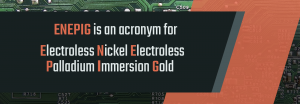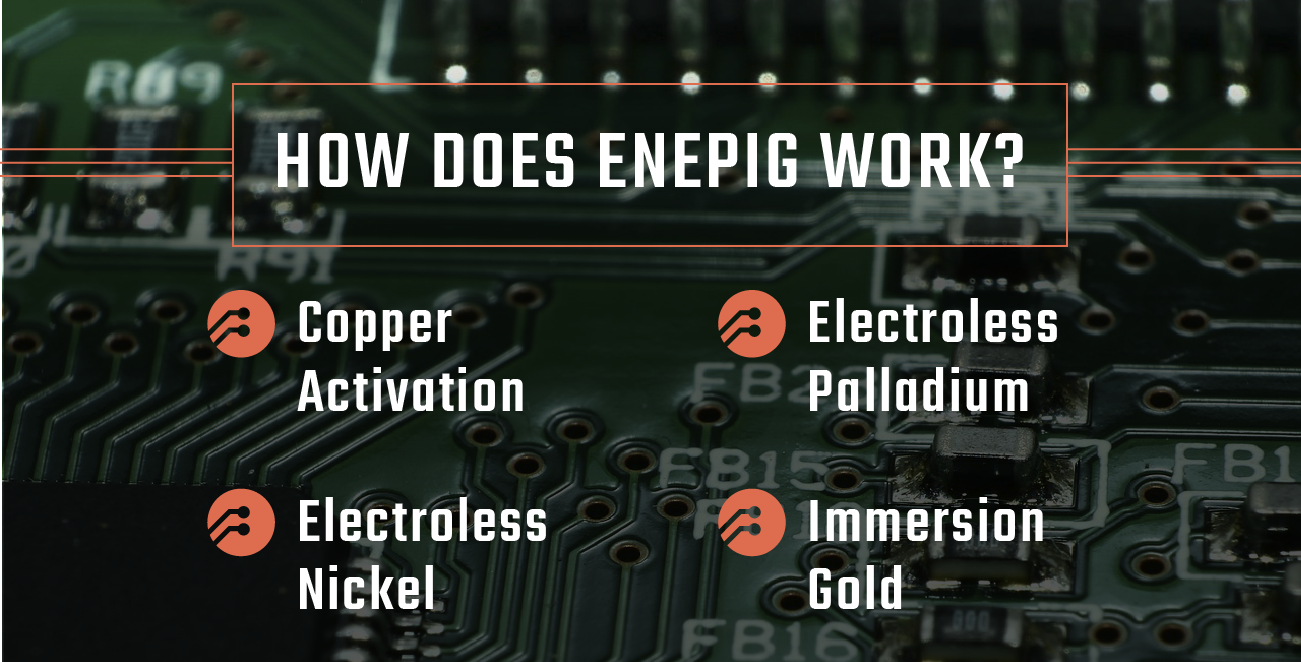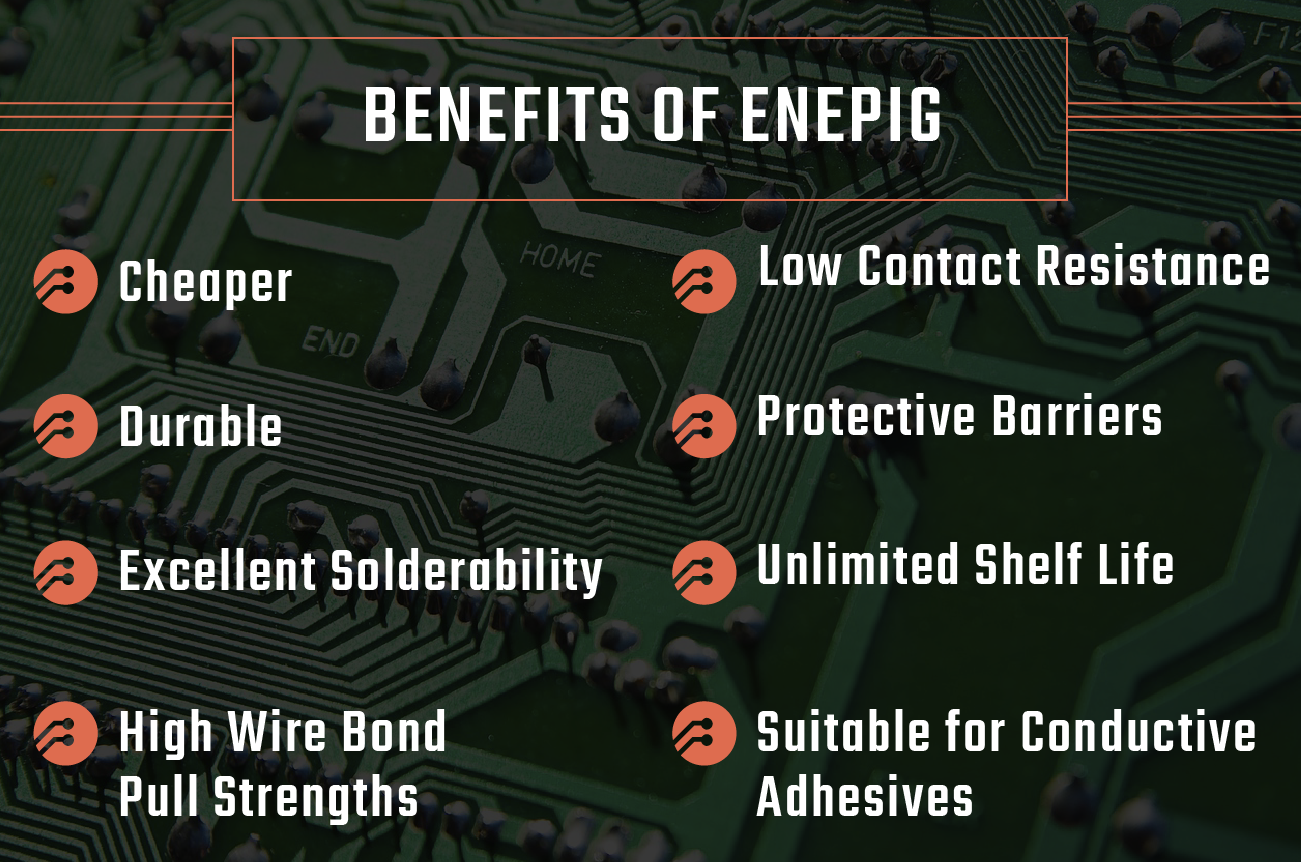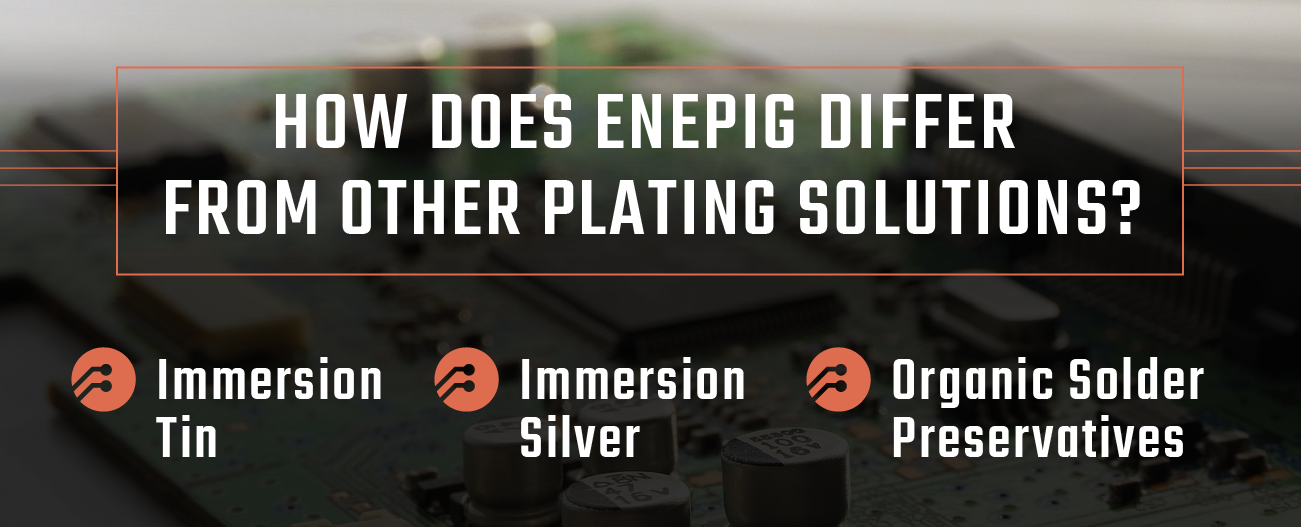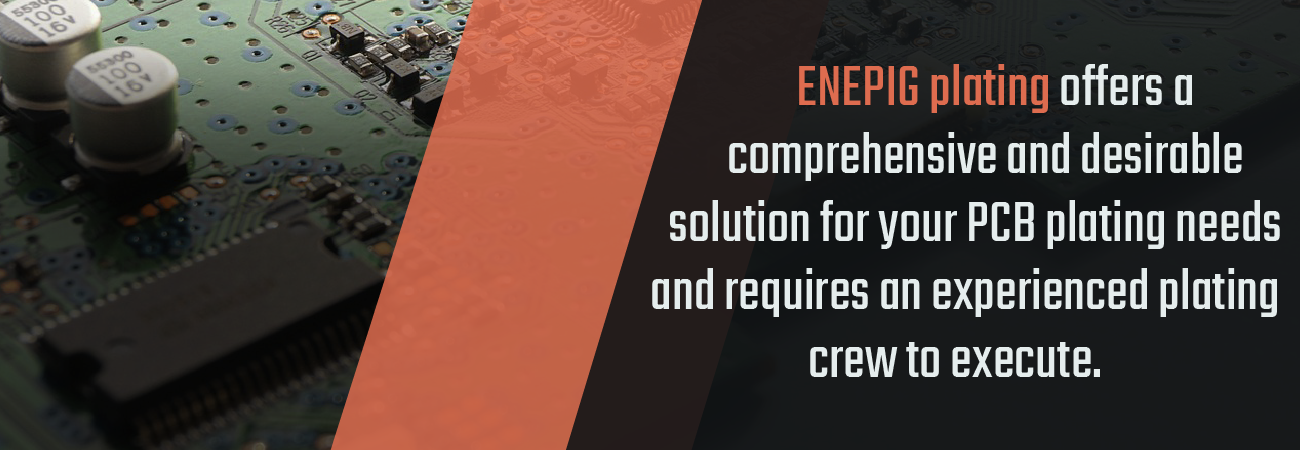Printed circuit board (PCB) manufacturing involves several technologies to bring about the desired results and functionalities. One of these technologies is the surface finish. The copper layer of a PCB oxidizes when it meets air, reducing the soldering ability of the copper. With a surface finish, however, the copper layer is protected from oxidation, maintaining the soldering and electrical performance of the material.
Several surface finishes are available for application, each of which elicits different results and is appropriate for different applications. One of these finishes is ENEPIG plating for PCBs. ENEPIG is an acronym for Electroless Nickel Electroless Palladium Immersion Gold. This type of finish offers abundant benefits that make it suitable for a variety of applications.
What is ENEPIG?
ENEPIG is a type of metal plating for PCBs. Developed around a decade ago, this kind of surface finish has gained popularity in recent years for its comparatively low cost to other types of gold plating for PCBs. Over the past several years, prices for palladium have substantially decreased compared to gold. By using palladium plating for PCBs instead of pure gold, PCB plating services can reduce plating costs, making ENEPIG a more popular electronic plating solution.
Nicknamed the “universal surface finish” for its ability to be deposited on just about any PCB assembly, ENEPIG finishes are primarily used to support soldering and gold and aluminum wire bonding. On top of these functionalities, ENEPIG plating also extends the functional shelf life of a plated PCB well beyond a year.
How Does ENEPIG Work?
ENEPIG involves four layers of metal deposited on a PCB surface. These are copper, nickel, palladium and gold. The process of creating an ENEPIG surface finish includes the following steps:
- Copper Activation: In this step, the copper layer that needs protection is selectively activated, which determines the deposition pattern in the electroless nickel plating step. This process is accomplished using a displacement reaction, which makes the copper layer act as a catalytic surface.
- Electroless Nickel: Nickel acts as a barrier layer, preventing copper from interacting with the other metals involved in this plating technology, particularly gold. The layer is deposited on the catalytic copper surface using an oxidation-reduction reaction. The result is a layer that is between 3.0 to 5.0 microns thick.
- Electroless Palladium: The layer of palladium is what differentiates ENEPIG from ENEG surface finish technology, acting as another barrier layer. Palladium prevents the nickel layer from corroding and diffusing into the gold layer. It also acts as an anti-oxidation and anti-corrosion layer. Like nickel, this layer is deposited using an electroless reaction, which uses a chemical oxidation-reduction reaction to cause the nickel surface to react with palladium and form a thin layer. This palladium is deposited on a layer with a thickness of 0.05 to 0.1 microns, depending on the application.
- Immersion Gold: Gold is the final layer added to ENEPIG surfaces, lending the benefits of low contact resistance, protection from friction and resistance to oxidation. Gold also preserves palladium’s solderability. As the name suggests, immersion gold plating services completely immerse the covered PCB, using a displacement reaction where palladium on the PCB dissolves and releases electrons that reduce the gold atoms surrounding it. The gold ions then attach to the surface of the PCB, replacing some palladium ions and resulting in a relatively thin outer layer, between 0.03 and 0.05 microns thick — substantially lower than any other solution using gold plating techniques.
Benefits of ENEPIG
Since its development in the late 1990s, ENEPIG has slowly grown in popularity as a plating option, with a recent surge in popularity resulting from reduced prices in raw palladium. The method is also popular due to its profound benefits, including the following:
- Cheaper: Despite the higher costs associated with the sheer number of processing steps involved in ENEPIG finishes, it’s overall much cheaper than electrolytic nickel/electrolytic gold (ENEG) plating. This is primarily because of the reduced material costs associated with ENEPIG plating compared to ENEG plating. ENEG plating requires relatively thick deposits of gold, due to the depositing method, while ENEPIG plating deposits much thinner layers of both gold and palladium. While palladium was much more expensive around the turn of the millennium, decreasing costs have made it a more cost-effective material than gold.
- Durable: The multiple layers of ENEPIG finishes are corrosion-resistant, owing primarily to the anti-corrosive properties of gold and palladium. This corrosion resistance actively prevents the occurrence of black nickel, which is the term used for the exterior appearance of nickel corrosion. The outer surface of an ENEPIG finish is also smooth and pore-free, meaning more corrosive elements are less likely to get trapped in the surface of the plating and eat away at the surface.
- Excellent Solderability: ENEPIG final plating offers excellent solder joint strength. The plating type is compatible with several different alloys during reflow soldering without lead, and can withstand multiple reflow soldering cycles without degrading. This compatibility is primarily because the palladium in the plating finish completely dissolves when soldered. The result is an oxide-free nickel surface that is ready for a stable nickel-to-tin connection for soldering.
- High Wire Bond Pull Strengths: Both aluminum and gold wires are well-supported by ENEPIG plating. After a series of testing, ENEPIG plating protects both aluminum and gold wire under long periods of stress. It also demonstrates excellent bondability to both gold and aluminum wire.
- Low Contact Resistance: Low contact resistance is essential in PCBs to prevent overheating, energy losses and poor grounding. ENEPIG finishes can guarantee this low resistance because the controlled deposition of nickel, palladium and gold makes the electrical resistance of the plating much more uniform.
- Protective Barriers: Both the nickel and palladium in an ENEPIG finish act as barrier layers, preventing the copper from being affected by the tin in solder. These barriers improve solderability immensely. They also prevent copper from mixing with gold and affecting conductivity.
- Suitable for Conductive Adhesives: Sometimes, solder isn’t the best choice for attaching components to a PCB. Instead, conductive adhesives may be a good option. ENEPIG supports the use of these adhesives, so you can connect components without using solder.
- Unlimited Shelf Life: Unlike many other plating options like silver, copper and aluminum, palladium and gold do not tarnish or oxidize. These are progressive conditions that result due to exposure to air and humidity. Both conditions result in reduced solderability and overall reduced quality of a finish, and both worsen over time. With gold and palladium protecting the finish, your PCBs can remain untarnished no matter how long they lay in storage.
Why Plate PCBs Using ENEPIG?
Modern PCBs continue to advance, resulting in smaller, lighter electronics that maintain maximum functionality and speed. To help improve functionality while also maintaining structural integrity, plating PCBs with a metallic finish has become a priority. Of all the plating options available, ENEPIG provides the greatest number of benefits while keeping processing and material costs relatively low. It also presents more benefits than other finishing options, like tin, silver, ENEG and ENIG plating, including excellent solderability, durability and anti-corrosive properties.
These benefits are not only important in consumer electronics, but also in a variety of other industries. ENEPIG finishes help maintain the high functionality and reliability of PCBs, making it an ideal finish for applications where reliability is a high priority. Just a few examples include the automotive, aerospace, military & defense and medical industries.
How Does ENEPIG Differ from ENIG and ENEG?
Three primary electroless process options are popular in PCB plating today. One is ENEPIG, but the other two are electroless nickel immersion gold (ENIG) and electroless nickel/electroless gold (ENEG). Of these, ENEPIG is the most popular and lowest in cost. The other differences between these processes include:
- ENIG: Electroless nickel immersion gold is a relatively easy process that is virtually identical to ENEPIG, except that it foregoes the palladium layer between the electroless nickel and immersion gold layers. It provides good oxidation resistance and electric performance, and is also temperature-resistant, with good thermal diffusion properties. However, ENIG surface finishes are only ever used in low-end consumer products due to their quality issues. For starters, ENIG surface finishes don’t provide reliable gold wire bonding results. This is because the interaction between tin and gold produces problematic intermetallics, resulting in reduced solder joint reliability. Additionally, proper processes are essential to prevent nickel corrosion, which is a common problem for solder joints on ENIG finishes.
- ENEG: Electroless nickel/electroless gold plating tends to result in better gold wire bonding than ENIG. However, the primary issue with this type of plating lies in cost. The thickness of the electroless gold layer is substantially higher than the other two plating options listed. The rising costs of gold have driven the price of ENEG plating to record highs. Additionally, the electroless gold process is much more complex than the immersion gold process, leading to increased labor and materials costs. In addition to being costly, ENEG plating’s thick gold exterior reduces solder joint reliability. This reduction in reliability is due to the problematic interaction between tin and gold, producing intermetallics that are less stable.
How Does ENEPIG Differ From Other Plating Solutions?
Outside the plating options listed above, three other final PCB finishes are often used for lead-free results. These are even more different from ENEPIG than ENEG and ENIG plating, and include the following:
- Immersion Tin: Tin is a common plating material, favored for its ability to form solder joints with tin material reliably. However, this material doesn’t bond well with other materials, particularly gold, and has no contact surface applications. It’s particularly prone to whiskering during surface mounting processes, which can contribute to PCB failure. The plating material is also exceedingly at risk of corrosion after assembly. Tin immersion plating results in a product with a shelf life of only three to six months, much shorter than any other plating method.
- Immersion Silver: Silver is another standard finishing material for covering a PCB, particularly favored for its beautiful finish and electrical testing compatibility. It’s also a material with an excellent shelf life, as it is resistant to corrosion. This material isn’t perfect for soldering, however. It doesn’t bond well to gold wiring and results in weak solder joints because of interfacial micro-voids that appear in the material. It also tends to tarnish under certain conditions, which can lead to even more problems with soldering.
- Organic Solder Preservatives: Also referred to as OSP, organic solder preservative is a finishing method that uses water-based organic compounds from the azole family for coatings. OSPs result in relatively reliable joints, but their performance tends to suffer as the number of reflows increases. They also tend to be relatively short-lived coatings, lasting less than one year due to the associated corrosion risks after assembly. They also have no contact surface applications and result in weak gold wire bonding. OSPs also provide a poor substrate for electrical test probes, so any testing has to happen during assembly before the plating process has begun.
None of these options is perfect, with issues relating to reflow cycle, wire bond capabilities and even shelf life. Compared to these options, ENEPIG offers an even more advantageous solution, with a long shelf life and performance reliability.
What to Watch Out for With ENEPIG
ENEPIG is hardly a new finish, having been around for over a decade. As such, the pitfalls of this plating method have been vigorously studied. Some of the biggest things to look out for in ENEPIG coating include the following:
- Cost: ENEPIG still runs on the higher end of the cost spectrum regarding coating materials, and tends to be superfluous if AU wire bonding or lead-free coating isn’t required. Most of this cost has to do with palladium and gold, which are high-cost precious metals. Even though the price of palladium has dropped below that of gold in recent years, it is still costly.
- Reliability: There are a few issues with regards to lead and tin bonding in ENEPIG, especially when compared to ENIG. Most of this has to do with the presence of copper and distribution of palladium.
- Fractures: ENEPIG coatings tend to be more prone to fractures, primarily due to the brittleness of the tin-palladium layers formed on top of the nickel plating.
Contact Sharretts Plating to Learn More
ENEPIG plating offers a comprehensive and desirable solution for your PCB plating needs and requires an experienced plating crew to execute. If ENEPIG is the right solution for you, choose the right plating company for the job.
Sharretts Plating Company has extensive experience in electronic plating services, including ENEPIG technology, and has been providing metal finishing solutions for almost a century. This means we have the expertise to help you select the best method for your application as well as the know-how to get it done. Whether you need ENEPIG plating, immersion gold plating services or palladium plating services, we can help you achieve the results you desire by developing a process that will meet your business needs while keeping your plating costs low.
Request a free quote for ENEPIG and other plating options today.


